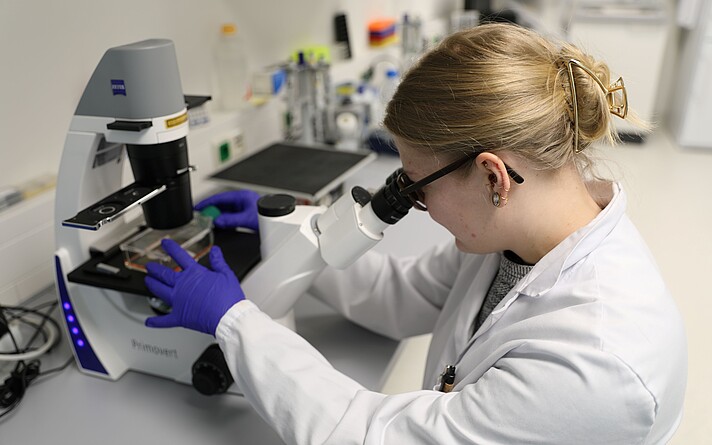We visit Sabrina Vorderegger in the Biomedical Sciences research laboratory at SALK. Sabrina started as a researcher at the Salzburg University of Applied Sciences in February, she was hired specifically for the Interreg project NETTLE. The aim of the project is to obtain natural extracts from various alpine plant species with interesting biological activities that are typical of the Austrian-Italian border region.

Sabrina is a molecular biologist and enjoys hiking in the mountains in her free time. Her main task over the next two years will be to determine the functional properties of the various plant species using different methods in the laboratory and to find out whether they are suitable for the development of medical applications in the future with regard to their antioxidant, antimicrobial and wound-healing properties. These would then be used in the treatment of skin diseases such as acne, neurodermatitis or epidermolysis bullosa.
The first step is to cultivate skin cells in the laboratory, which are then used to test the various extracts. These are sown in special culture flasks and receive all the nutrients they need to grow via cell culture medium. The skin cells adhere to the bottom of the bottles and double in size approximately every 24 hours. For the experiments, the skin cells are then sown in cell culture plates. The skin cells are then visually assessed to see whether the surface is covered with overgrowth. It is also checked whether no contamination is visible and whether the cells "look healthy". Before you can carry out experiments with cells, you have to make sure that the cells have grown optimally and are doing well. Only then can you be sure that the results of the experiments are correct and usable.
The extracts of the plants are first tested to determine whether they are toxic, i.e. poisonous. In order to determine this so-called cytotoxicity, the extract is applied to the cells in various concentrations to determine how the ingredients in it affect the viability of the cell.
The cells are treated with the extracts for 24 hours, after which a resazurin solution is applied to the cells, as shown in the photos. Resazurin is a blue dye that is converted into resorufin by healthy cells with a functioning metabolism. Resorufin is pink and highly fluorescent, so it can be easily detected with a fluorescence spectrometer. The higher the fluorescence measured, the healthier the cells are.
After testing an extract for cytotoxicity, you know what concentration to use for the remaining tests. The influence on wound healing, antibacterial and antioxidant properties can then be determined with further experiments.
The first test candidate in the laboratory is yarrow (Achillea millefolium). Yarrow has long been used in folk medicine to treat digestive disorders and to care for facial skin. It will therefore be exciting to see whether antioxidant and wound-healing properties can also be demonstrated for yarrow in the laboratory. Other candidates in the NETTLE project include thyme (Thymus vulgaris), peppermint (Menta piperita), lemon balm (Melissa officinalis), arnica (Arnica montana), hawthorn (Crataegus oxyacantha), alpine lady's mantle (Alchemilla alpina) and many more.
